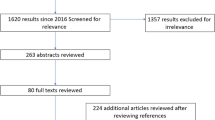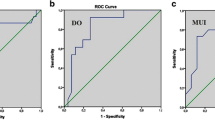Abstract
Purpose
To provide a narrative review of literature evaluating ultrasound techniques for the measurement of bladder wall hypertrophy in women as an alternative to invasive urodynamic assessment for the diagnosis of lower urinary tract symptoms (LUTS).
Methods
A literature review was performed using PubMed and all paper journals of congress abstracts searching for articles on ultrasound measurement of bladder wall thickness (BWT) or detrusor wall thickness (DWT) published between January 1990 and May 2012. Each study was classified with a level of evidence using the Oxford Centre for Evidence-based Medicine classification (2009).
Results
Ultrasound measurement of bladder wall hypertrophy is not standardised, and techniques vary widely according to anatomical approach, ultrasound frequency and other factors. This review compared transvaginal, translabial/transperineal and suprapubic approaches for ultrasound BWT/DWT measurement. BWT/DWT measurements correlated well with urodynamic diagnoses of detrusor overactivity (DO) using all three ultrasound techniques. BWT values were consistently higher in women with DO than in women with stress incontinence, although threshold values for the differential diagnosis of DO varied between clinical studies (5.0–6.5 mm using transvaginal ultrasound). Few data were available on the use of translabial or suprapubic ultrasound in women. Inter- and intraobserver variability was higher with transperineal and suprapubic ultrasound, and these techniques appear less reliable than transvaginal ultrasound. Studies suggest that BWT is reduced in response to antimuscarinic therapy in women with overactive bladder or DO.
Conclusions
Data from clinical trials suggest that transvaginal ultrasound measurement of BWT is a reliable method of diagnosing DO in women with LUTS, and BWT decreases during antimuscarinic therapy.


Similar content being viewed by others
Abbreviations
- BOO:
-
Bladder outlet obstruction
- BWT:
-
Bladder wall thickness
- DO:
-
Detrusor overactivity
- DWT:
-
Detrusor wall thickness
- LUTS:
-
Lower urinary tract symptoms
- MHz:
-
Mega Hertz
- MUI:
-
Mixed urinary incontinence
- OAB:
-
Overactive bladder
- SD:
-
Standard deviation
- SUI:
-
Stress urinary incontinence
- 95 % CI:
-
95 % confidence interval
References
Haylen BT, De Ridder D, Freeman RM, Swift SE, Berghmans B, Lee J, Monga A, Petri E, Rizk DE, Sand PK et al (2010) An International Urogynecological Association (IUGA)/International Continence Society (ICS) joint report on the terminology for female pelvic floor dysfunction. Neurourol Urodyn 29:4–20
Ashok K, Wang A (2010) Detrusor overactivity: an overview. Arch Gynecol Obstet 282:33–41
Siegel SW, Richardson DA, Miller KL, Karram MM, Blackwood NB, Sand PK, Staskin DR, Tuttle JP (1997) Pelvic floor electrical stimulation for the treatment of urge and mixed urinary incontinence in women. Urology 50:934–940
Antunes-Lopes T, Carvalho-Barros S, Cruz CD, Cruz F, Martins-Silva C (2011) Biomarkers in overactive bladder: a new objective and noninvasive tool? Adv Urol. doi:10.1155/2011/382431
Klingler HC, Madersbacher S, Djavan B, Schatzl G, Marberger M, Schmidbauer CP (1998) Morbidity of the evaluation of the lower urinary tract with transurethral multichannel pressure-flow studies. J Urol 159:191–194
Porru D, Madeddu G, Campus G, Montisci I, Scarpa RM, Usai E (1999) Evaluation of morbidity of multi-channel pressure-flow studies. Neurourol Urodyn 18:647–652
Anders K, Cardozo L, Ashman O, Khullar V (2002) Morbidity after ambulatory urodynamics. Neurourol Urodyn 21:461–463
Cartwright R, Afshan I, Derpapas A, Vijaya G, Khullar V (2011) Novel biomarkers for overactive bladder. Nat Rev Urol 8:139–145
Levin RM, O’Connor LJ, Leggett RE, Whitbeck C, Chichester P (2003) Focal hypoxia of the obstructed rabbit bladder wall correlates with intermediate decompensation. Neurourol Urodyn 22:156–163
Oelke M (2010) International Consultation on Incontinence-Research Society (ICI-RS) report on non-invasive urodynamics: the need of standardization of ultrasound bladder and detrusor wall thickness measurements to quantify bladder wall hypertrophy. Neurourol Urodyn 29:634–639
Khullar V, Salvatore S, Cardozo L, Bourne TH, Abbott D, Kelleher C (1994) A novel technique for measuring bladder wall thickness in women using transvaginal ultrasound. Ultrasound Obstet Gynecol 4:220–223
Khullar V, Cardozo LD, Salvatore S, Hill S (1996) Ultrasound: a noninvasive screening test for detrusor instability. Br J Obstet Gynaecol 103:904–908
Kuhn A, Bank S, Robinson D, Klimek M, Kuhn P, Raio L (2010) How should bladder wall thickness be measured? A comparison of vaginal, perineal and abdominal ultrasound. Neurourol Urodyn 29:1393–1396
Robinson D, Anders K, Cardozo L, Bidmead J, Toozs-Hobson P, Khullar V (2002) Can ultrasound replace ambulatory urodynamics when investigating women with irritative urinary symptoms? BJOG 109:145–148
Serati M, Salvatore S, Cattoni E, Soligo M, Cromi A, Ghezzi F (2010) Ultrasound measurement of bladder wall thickness in different forms of detrusor overactivity. Int Urogynecol J 21:1405–1411
Kuhn A, Genoud S, Robinson D, Herrmann G, Gunthert A, Brandner S, Raio L (2011) Sonographic transvaginal bladder wall thickness: does the measurement discriminate between urodynamic diagnoses? Neurourol Urodyn 30:325–328
Ibrahim S, Najdy M (2011) Measuring bladder wall thickness in cases of detrusor instability using transvaginal ultrasound. International Continence Society annual meeting, Glasgow, UK (abstract 676)
Parsons M, Vella M, Cardozo L (2005) Does bladder wall thickness discriminate detrusor overactivity from overactive bladder and normality? International Continence Society annual meeting, Montreal, Canada (abstract 383)
Kuo HC (2009) Measurement of detrusor wall thickness in women with overactive bladder by transvaginal and transabdominal sonography. Int Urogynecol J Pelvic Floor Dysfunct 20:1293–1299
Yang JM, Huang WC (2003) Bladder wall thickness on ultrasonographic cystourethrography: affecting factors and their implications. J Ultrasound Med 22:777–782
Yang J-M, Huang W-C (2002) Discrimination of bladder disorders in female lower urinary tract symptoms on ultrasonographic cystourethrography. J Ultrasound Med 21:1249–1255
Oswald J, Schwentner C, Lunacek A, Fritsch H, Longato S, Sergi C, Bartsch G, Radmayr C (2006) Reevaluation of the fetal muscle development of the vesical trigone. J Urol 176:1166–1170
Panayi DC, Tekkis P, Fernando R, Hendricken C, Khullar V (2010) Ultrasound measurement of bladder wall thickness is associated with the overactive bladder syndrome. Neurourol Urodyn 29:1295–1298
Otsuki E, Castro R, Sartori MGF, Girao MJBC, Jarmy-Di Bella Z (2010) Is there a difference in bladder wall thickness between continent and women with stress urinary incontinence or overactive bladder? International Urogynecological Association annual meeting, Toronto, Canada (abstract 934)
Panayi D, Khullar V, Fernando R, Hendricken C, Tekkis P (2009) Is ultrasound bladder wall thickness a better objective measure than urodynamics for overactive bladder symptoms? International Continence Society annual meeting, San Francisco, USA (abstract 160)
Lekskulchai O, Dietz HP (2008) Detrusor wall thickness as a test for detrusor overactivity in women. Ultrasound Obstet Gynecol 32:535–539
Lekskulchai O, Dietz HP (2009) Is detrusor hypertrophy in women associated with voiding dysfunction? Aust N Z J Obstet Gynaecol 49:653–656
Minardi D, Piloni V, Amadi A, El Asmar Z, Milanese G, Muzzonigro G (2007) Correlation between urodynamics and perineal ultrasound in female patients with urinary incontinence. Neurourol Urodyn 26:176–182
Oelke M, Hofner K, Wiese B, Grunewald V, Jonas U (2002) Increase in detrusor wall thickness indicates bladder outlet obstruction (BOO) in men. World J Urol 19:443–452
Oelke M, Hofner K, Jonas U, de la Rosette JJ, Ubbink DT, Wijkstra H (2007) Diagnostic accuracy of noninvasive tests to evaluate bladder outlet obstruction in men: detrusor wall thickness, uroflowmetry, postvoid residual urine, and prostate volume. Eur Urol 52:827–834
Chung SD, Chiu B, Kuo HC, Chuang YC, Wang CC, Guan Z, Chancellor MB (2010) Transabdominal ultrasonography of detrusor wall thickness in women with overactive bladder. BJU Int 105:668–672
Kuo HC, Liu HT, Chancellor MB (2010) Urinary nerve growth factor is a better biomarker than detrusor wall thickness for the assessment of overactive bladder with incontinence. Neurourol Urodyn 29:482–487
Ozturk H, Aydur E, Irkilata HC, Seckin B, Dayanc M (2011) The diagnostic role of transabdominal ultrasonographic bladder wall thickness in female urinary incontinence. International Continence Society annual meeting, Glasgow, UK (abstract 388)
Blatt AH, Titus J, Chan L (2008) Ultrasound measurement of bladder wall thickness in the assessment of voiding dysfunction. J Urol 179:2275–2279
Panayi DC, Khullar V, Fernando R, Tekkis P (2010) Transvaginal ultrasound measurement of bladder wall thickness: a more reliable approach than transperineal and transabdominal approaches. BJU Int 106:1519–1522
Ke Q-S, Kuo H-C (2011) The promise of bladder wall thickness as a useful biomarker for objective diagnosis of lower urinary tract dysfunction. Tzu Chi Med J 23:1–8
Khullar V, Salvatore S, Cardozo L, Hill S (1994) Bladder wall thickness: an objective measure of drug efficacy? Int Urogynecol J 5, 327 (abstract 33)
Khullar V, Hill S, Cardozo L, Amos C, Guan Z (2007) A multi-centre, randomised, placebo-controlled, double-blind, parallel group study to evaluate whether tolterodine extended release can reverse the increased bladder wall thickness in women with overactive bladder. International Continence Society annual meeting, Rotterdam, The Netherlands (abstract 124)
Panayi DC, Tekkis P, Fernando R, Khullar V (2010) Is the beneficial effect of antimuscarinics related to motor or sensory changes in the bladder? Int Urogynecol J 21:841–845
Robinson D, Oelke M, Khullar V, Tretter R, Stow B, Compion G, Tubaro A (2012) Bladder wall thickness in women with symptoms of overactive bladder and detrusor overactivity: baseline data from the SHRINK study. European Association of Urology annual meeting Paris, Late breaking abstract
Acknowledgments
The research for this review was undertaken with a grant from Astellas Pharma Europe Ltd. All authors had full access to all the data in the study and the primary author (MO) had final responsibility for the decision to submit this manuscript for publication. Writing and editorial assistance was provided by Matthew Cunningham and Lindsay Napier of Darwin Healthcare Communications, and was funded by Astellas.
Conflict of interest
Matthias Oelke has received Lecturer and/or Consultant Honoraria from Apogepha, Astellas and Pfizer, and received a research grant from Astellas. Vik Khullar is a Consultant and Speaker for Astellas, Pfizer and Allergan. Hessel Wijkstra has received Consultant Honoraria from Astellas.
Author information
Authors and Affiliations
Corresponding author
Rights and permissions
About this article
Cite this article
Oelke, M., Khullar, V. & Wijkstra, H. Review on ultrasound measurement of bladder or detrusor wall thickness in women: techniques, diagnostic utility, and use in clinical trials. World J Urol 31, 1093–1104 (2013). https://doi.org/10.1007/s00345-013-1030-6
Received:
Accepted:
Published:
Issue Date:
DOI: https://doi.org/10.1007/s00345-013-1030-6




